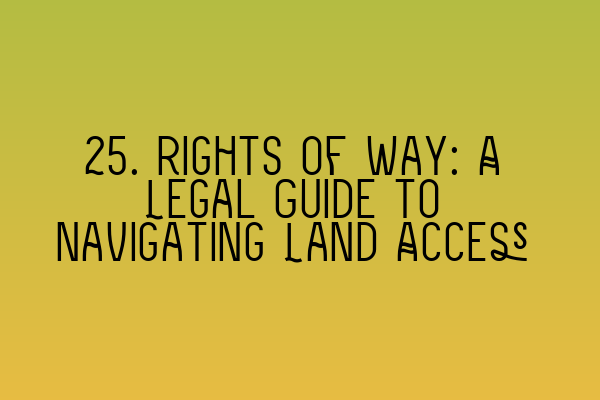Rights of Way: A Legal Guide to Navigating Land Access
Welcome to SQE Property Law & Land Law, your trusted partner for all your property law needs. In this blog post, we will provide you with a comprehensive legal guide to rights of way and how to navigate land access. Whether you are a property owner, buyer, or developer, understanding your rights and obligations regarding access to land is crucial. So, let’s dive right in!
What is a Right of Way?
A right of way refers to the legal right to access or cross another person’s property. It allows individuals to pass through or use a specific pathway, road, or track, even if they do not own the land. Rights of way can be vital for various purposes, including allowing access to public places, connecting neighboring properties, or providing access to utilities.
It is important to note that rights of way can be either public or private. Public rights of way are typically established by law and grant access to the general public. On the other hand, private rights of way are created through agreements or legal documents between specific individuals or entities.
Types of Rights of Way
There are several types of rights of way that property owners or users should be aware of:
- Footpath: A footpath is a right of way that allows pedestrians to pass through a property. It is typically used for walking, hiking, or recreational purposes.
- Bridleway: A bridleway is a right of way that permits pedestrians, horse riders, and cyclists to traverse a property. It provides a designated route for horse riding and cycling enthusiasts.
- Byway Open to All Traffic (BOAT): A BOAT is a right of way that allows all types of vehicles, including motorized vehicles, to access a property. It is commonly used for agricultural or recreational purposes.
- Private right of way: A private right of way is created through a legal agreement between parties and grants specific individuals or entities access to a property or specific areas within a property. Often, private rights of way are associated with shared driveways or access to amenities within a development.
Establishing and Preserving Rights of Way
Establishing and preserving rights of way require careful attention to legal procedures and documentation. Here are some key steps:
- Check the Title Deeds: Start by reviewing the title deeds of the property. They may contain information about existing rights of way.
- Consult Legal Experts: Seek advice from a solicitor specializing in property law. They can assist in identifying and interpreting any existing rights of way.
- Negotiate Agreements: If a private right of way is required, negotiate the terms and conditions with the relevant parties. It is crucial to document the agreement in a legally binding contract.
- Register the Right of Way: It is recommended to register any private rights of way with the Land Registry. This will provide legal protection and ensure that future owners or occupants are aware of the existence of the right of way.
- Resolve Disputes: In case of disputes or disagreements regarding rights of way, seeking the assistance of a solicitor specializing in property litigation is advised. They can help resolve conflicts and protect your rights.
Common Issues and Considerations
When dealing with rights of way, several common issues and considerations should be taken into account:
- Maintenance and Repair: Determine who is responsible for the maintenance and repair of the access route. This includes ensuring the pathway remains safe and accessible.
- Scope of Use: Clearly define the scope of use for the right of way. This includes specifying whether it is for pedestrian use only or if it allows vehicular access.
- Restrictions: Understand any restrictions that may be imposed on the right of way, such as limitations on hours of use or activities permitted.
- Termination: Be aware of circumstances that may lead to the termination of a right of way, such as the closure of a public footpath due to development works.
Conclusion
Rights of way are a fundamental aspect of property law, providing individuals with the legal right to access or cross another person’s property. Whether it is a public footpath, bridleway, or private right of way, understanding the legal implications is essential for property owners, buyers, and developers alike. We hope this comprehensive guide has shed light on the intricacies of navigating land access and the importance of preserving rights of way.
For more information on property law, SQE exam preparation, or to explore our range of courses, please visit our related articles:
- SQE 1 Practice Exam Questions
- SQE 1 Practice Mocks FLK1 FLK2
- SQE 2 Preparation Courses
- SQE 1 Preparation Courses
- SRA SQE Exam Dates
Thank you for reading, and if you have any further questions or require legal assistance, do not hesitate to contact SQE Property Law & Land Law. Our team of experts is always ready to help you navigate the complex field of property law.
